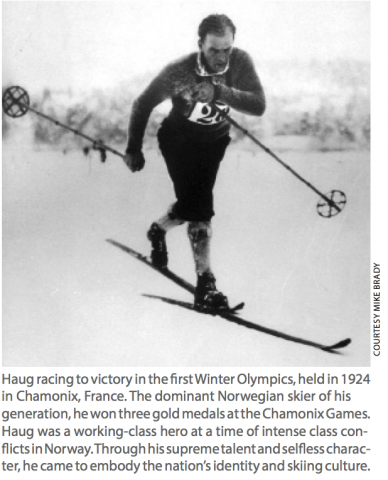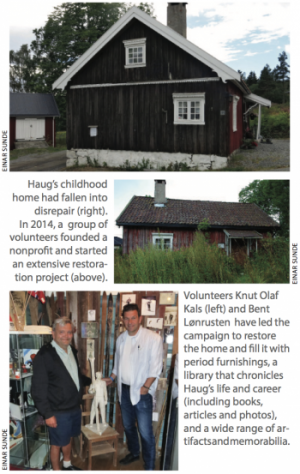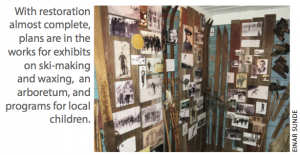
Volunteers are restoring the childhood house of Norwegian ski legend Thorleif Haug. By Einar Sunde
On August 1 of this year, I stepped off the train at the Lier station, 27 miles west of Oslo, and was greeted warmly by Knut Olaf Kals. Knut is the moving force behind the restoration of the childhood home of Norwegian ski legend Thorleif Haug, who won triple gold at the first Winter Olympics in 1924 in Chamonix.
We drove to a small place called Årkvisla in the hilly northwestern end of the Lier Valley, where scattered farmhouses lie close to the forest. The 18th century house (Haugstua) is now quite charming, but a quick glance around the area was all it took to realize that life here must have been very hard in the early 1900s. Waiting for us was Knut’s friend and fellow volunteer Bent Lønrusten. I was promptly invited inside for coffee, homemade waffles and jam, and a lot of history.
Haug was born in 1896 and the family moved here soon after he started his schooling. In the winter, he skied to and from school. By the time he was a young teenager he was doing physically demanding forestry work, requiring extensive use of skis in the winter. In the process, Haug became a skilled skier and superbly fit. He began competing in local races and by 1919 he had become the most dominant Norwegian skier of that generation (see sidebar). But Knut stressed what Haug’s teammates and competitors said: What really set him apart was the combination of supreme talent with personal modesty and selflessness. In addition, he was a working-class hero at a time of intense class conflicts in Norway, when the skiing “establishment” and a high percentage of the capital’s competitive skiers were from the upper class. Haug touched people in a unique way. Journalists referred to him as Skikongen (the King of Skiing), but to ordinary people he was simply Hauer’n. After his triple gold at the 1924 Winter Games, Haug entered another realm altogether: Norway had been independent from Sweden for only 19 years and, through his skiing exploits and his character, he became the embodiment of Norwegian identity and its skiing culture.

After the 1924 season, Haug married and retired from competition to earn a living as a plumber in nearby Drammen (surfacing briefly in 1926 to compete in the nordic combined at the World Championships in Finland). His sudden death from pneumonia in December of 1934 shocked the country and an estimated 20,000 people lined the streets of Drammen to view the funeral procession and pay their respects. Posthumous honors followed, including the first statue ever of a Norwegian athlete (with Crown Prince Olav speaking at the dedication in 1946) and a memorial race in his honor that continues to this day. But as time passed Haugstua, vacant for years, fell into disrepair.
Knut grew up in the area and was quite familiar with the story of Haug. In 2014 he read an article in a local newspaper that mentioned how many locals were ashamed by the neglect of the old house. With a background in business and marketing, he decided he could make a real difference. By the end of the year he had contacted and convinced Bent and other locals to form Skikongen Thorleif Haugs Venner as an association dedicated to restoring Haugstua and promoting Haug’s legacy. Knut and Bent showed me the impressive array of projects completed to date: replacement of the roof and some structural beams, repair of the chimney, repair and replacement of windows (with period sash and glass), replacement of siding, new insulation and flooring in the attic, and painting and treating the exterior. They’ve also created a cozy interior with period furnishings and a wealth of photos, articles and books about Haug, and related skis and other artifacts. All work to date has been a labor of love by the association’s members and supporters.
Knut emphasized that while the repair and restoration work is almost finished, there is much more to do. They will soon change the legal structure from a simple association to a stiftelse, much like a nonprofit corporation in the USA. Specific projects are in the works on several fronts that connect at various levels to Haug, including a ski-making exhibit in the attic (Haug’s father made skis for the family and others), a ski waxing exhibit (reflecting Haug’s extensive experiments in creating better ski waxes), the establishment of an arboretum on the property (in honor of Haug’s interest in gardening and nature), and programs for children (Haug gave many hundreds of pairs of skis to children). The association is also campaigning to have the statue of Haug
, now in Drammen, relocated to the Årkvisla property, as well as reaching out to local, national and international private and public entities to forge relationships, collaborate on projects and seek support for future activities.

Having witnessed Knut and Bent’s passion for this mission in person, I have no doubt they will succeed. I also know they would welcome visitors by a
ppointment as they welcomed me, though I can’t guarantee you’ll be offered homemade waffles and cloudberry jam. But waffles or not, you will leave Haugstua imbued with the infectious spirit of Thorleif Haug.
To learn more or to visit Haugstua, contact Knut Olaf Kals by email: Knut.Olaf.Haveraen.Kals@polier.no or kals@skikongen.com. The association has a Facebook page at “La oss bevare Thorleif Haugs barndomshjem for ettertiden.”
Einar Sunde is an attorney in Palo Alto, California. Raised in Norway, he is an amateur ski historian, ISHA director and jury member for the ISHA Awards.
Haug By the Numbers
Thorleif Haug was a Norwegian skier who dominated cross-country skiing and nordic combined during the early 1920s. Here are the highlights of his athletic career.
Holmenkollen (Oslo, Norway)
> First place in nordic combined: 1919, 1920, 1921
> First place in 50 km: 1918, 1919, 1920, 1921, 1923, 1924
The Holmenkollen was the premier skiing competition in Norway at the time. During these years, the only events were the 50 km and the nordic combined (cross country and jumping).
1924 Winter Olympics (Chamonix, France)
> Gold in 18 km
> Gold in 50 km
> Gold in nordic combined
> Fourth place in special jumping
1926 World Championships (Lahti, Finland)
> Silver in nordic combined
Other competitions
> More than 55 first places and 18 second places in events across Norway, Sweden and Finland.
